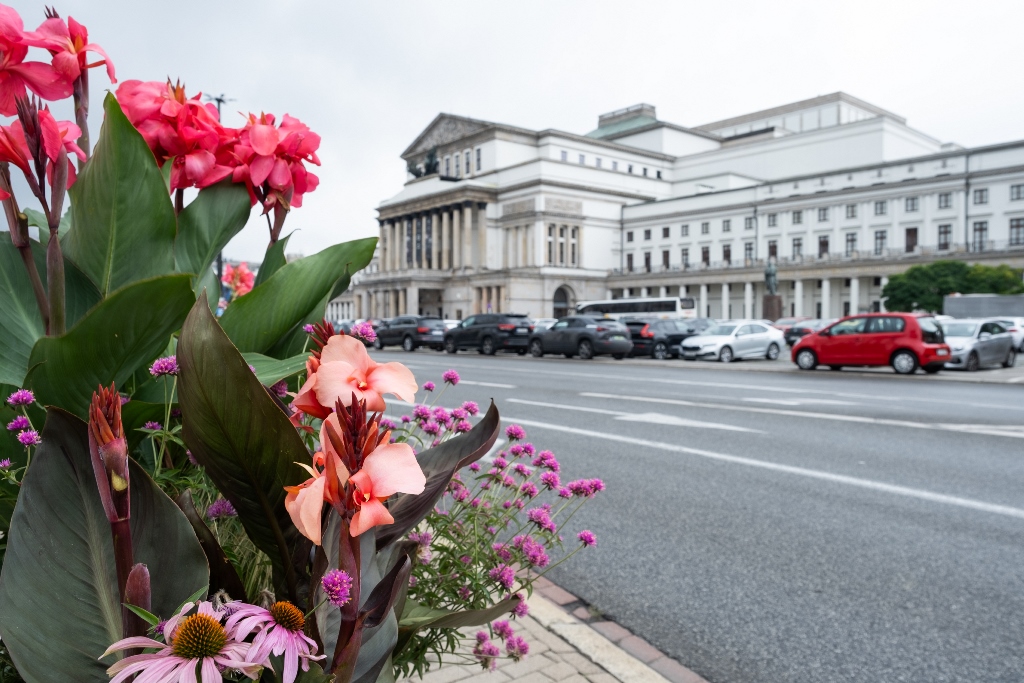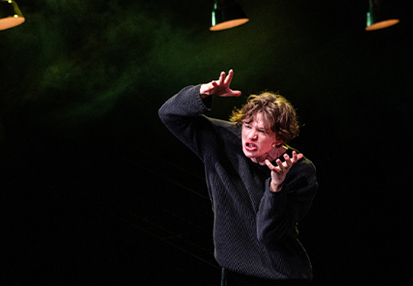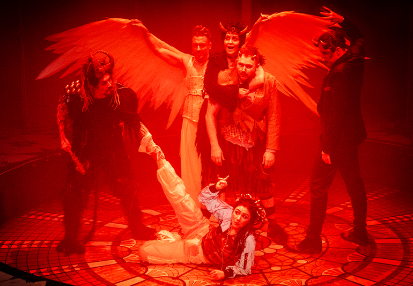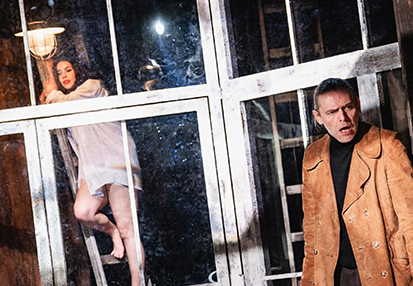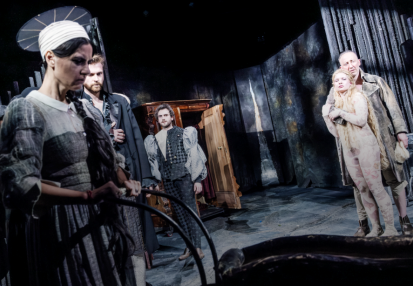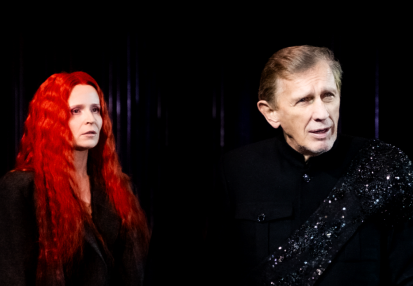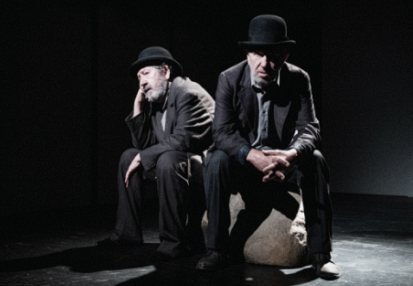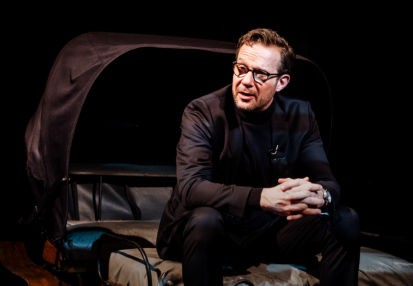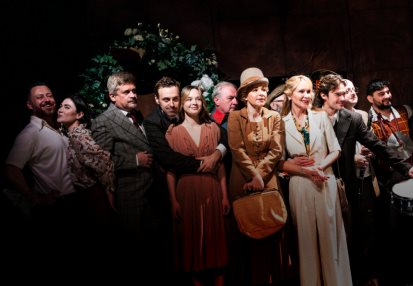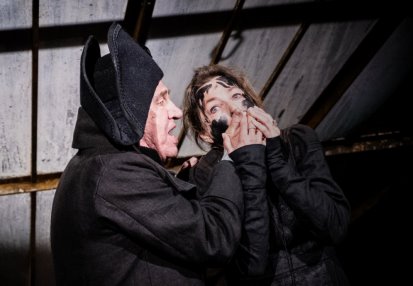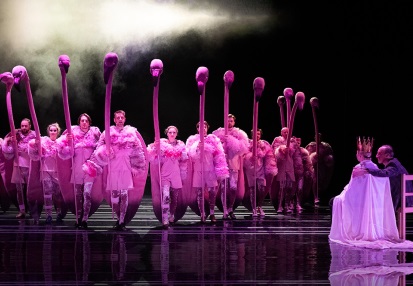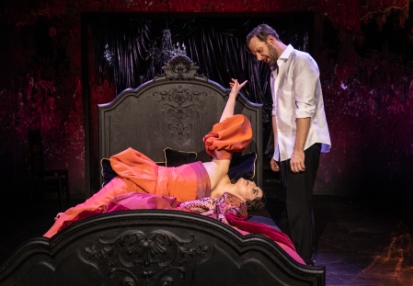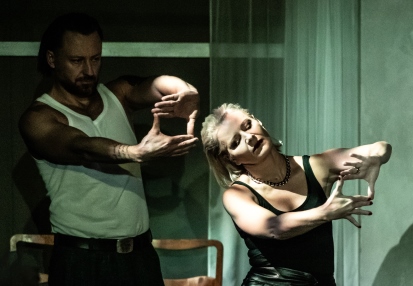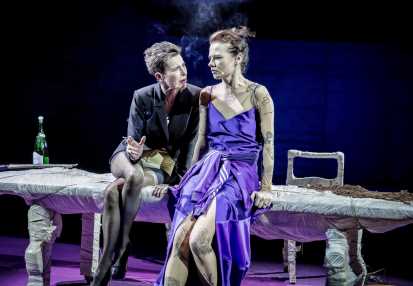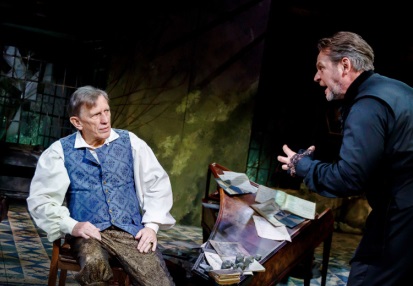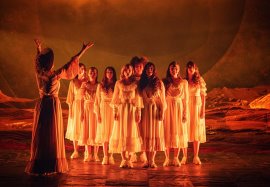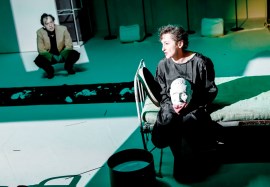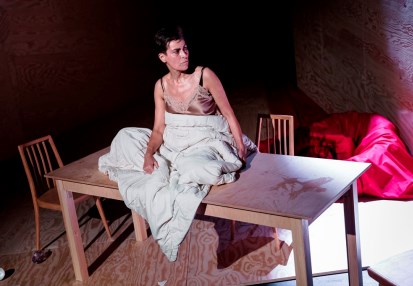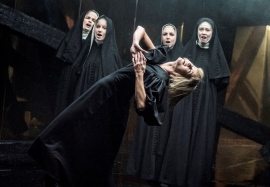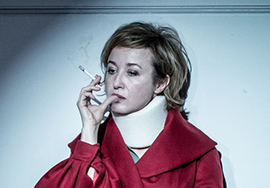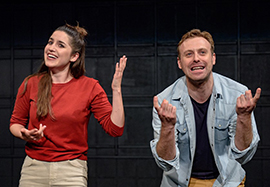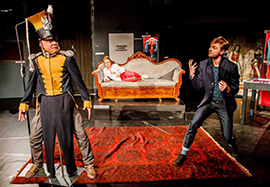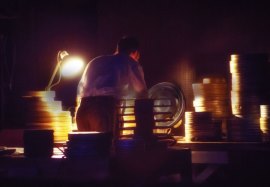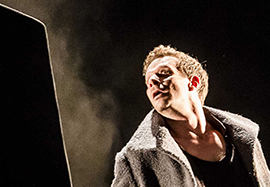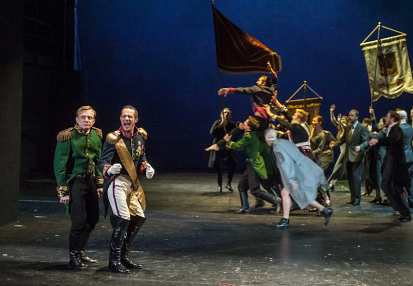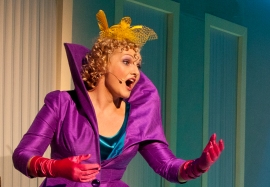The Seat of the National Theatre
The National Theatre opened on 19 November 1765 with a performance of Józef Bielawski's comedy Natręci (‘Bothersome People’). At the time, it did not have a building of its own. Together with various foreign-language troupes, it performed at the so-called “Operalnia” at the intersection of today's Marszałkowska and Królewska streets in Warsaw, and later on in an annex of the Radziwiłł Palace (now Poland’s Presidential Palace) on Krakowskie Przedmieście street.
In 1779, a purpose-built site for the National Theatre opened on Krasiński Square, where the current Supreme Court building stands today. The theatre was located there for the next half a century, and it was this building that was associated with the turbulent events of the era of the Theatre’s director Wojciech Bogusławski and the later classicist period.
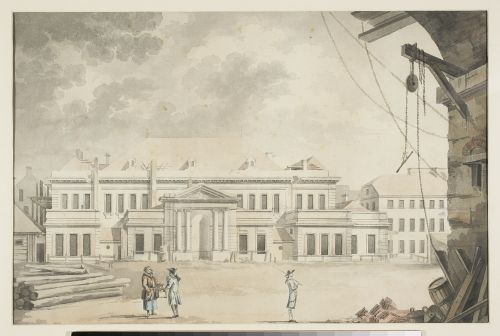
Zygmunt Vogel, the National Theatre on Krasiński Square in Warsaw, ca. 1791 / public domain
In 1825, construction began of a new theatre designed by Antonio Corazzi and funded by the city. It was to be a large, impressive building and would stage dramatic, musical and ballet performances. It would be built on the then Marywil Square (now Theatre Square, aka Plac Teatralny). The cornerstone was laid on 19 November 1825 – on the sixtieth anniversary of the establishment of the National Theatre – in the presence of government ministers, all the Theatre’s actors, and a crowd made up of the general public.
Construction of the main building progressed slowly, with only the foundations being completed by 1827. In the meantime, in 1829, the second stage of the National Theatre was opened in the auditorium of the Charity Society building on Krakowskie Przedmieście street (rebuilt after World War II, it still stands to this day, with the distinctive inscription "Res sacra miser" on its façade). This stage was called the Variety Theatre.
Following the outbreak of the November Uprising in 1830, the unfinished new building served as a grain warehouse and was later occupied by Russian troops. Because the uprising was unsuccessful, the word "National" could not appear in the name of the theatre or on the façade of the building, so it was preserved only in Corazzi's design. The Russian authorities decided to give the building a new name: the Grand Theatre. The impressive building featured four storeys of boxes, galleries with a parade, and an auditorium with chairs. It opened to the public on 24 February 1833 with an inaugural performance of The Barber of Seville.
In 1833, the Variety stage was moved to the Grand Theatre's Redutowe Halls. Three years later, it was moved again to its final location in the west wing of the Grand Theatre, with its main entrance being on Wierzbowa Street. Drama performances began to be performed mainly on this stage, and the National Theatre occupies it to this day.
The Variety auditorium initially had 1,000 seats. The theatre was cramped and poorly ventilated and the first fire broke out there in 1883. Fortunately, it was when the theatre was not working. Reconstruction took just over half a year. The corridors were widened, and the main entrance was moved to the adjacent Square.
Another fire occurred at the Variety Theatre on November 2, 1919, less than a year after Poland regained independence. For a few years, the repertory actors performed in the Summer Theatre’s wooden building in the nearby Saxon Garden. In turn, the experimental Reduta Theatre began staging productions in the Redutowe Halls. Under the direction of Juliusz Osterwa, Reduta performed a Polish repertoire and trained its ensemble in an innovative way.
At the same time, the reconstruction of the former Variety Theatre got underway. After five years, the building opened on October 3, 1924, now as the National Theatre. It was separate from the opera and ballet, and was not a state-run theatre. It was operated by the city authorities; when their patronage collapsed due to the economic crisis in the 1930s, the stage was taken over by an organisation called the Society for the Promotion of Theatre Culture, functioning as a public-private partnership.
In 1928, the National Theatre opened another intimate stage in the Redutowe Halls of the Grand Theatre, and it was named the New Theatre. The National Theatre thus survived in this form until the outbreak of World War II.
The Theatre partially burned down during aerial bombing in September 1939, and then was completely destroyed during the planned destruction of Warsaw carried out by the Nazis following the failure of the Warsaw Uprising in the autumn of 1944. After the war, the National Theatre was rebuilt relatively quickly by military personnel. The first post-war premiere took place on 13 December 1949.
In 1973, the Theatre, which had only performed on one main stage since the war, once again gained an intimate hall: the Small Theatre in the basement of the "Relax" cinema, with an entrance opening onto Marszałkowska Street.
A decade later, in March 1985, as a result of a short circuit in the electrical system, the National Theatre burned down for the fifth time in its history. Rebuilding lasted eleven long years. For part of this period, the theatre used the temporary location of Warsaw’s Theatre in Wola. After the fall of socialism in 1989, the organisation was disbanded and all its elements took the form of the National Theatre Institute, which, on the one hand, carried out work related to the rebuilding the main theatre building, and on the other, staged performances and organised events by foreign theatrical troupes on the surviving stage of the Little Theatre.
The rebirth of the Theatre took place on 19 November 1997, when the National Theatre resumed its activities in its rebuilt and reconstructed location with a ceremonial premiere of Stanisław Wyspiański's Noc listopadowa (“A November Night”) directed by Jerzy Grzegorzewski, the then new artistic director. A newly erected building on the opposite side of Wierzbowa Street was also put into use, where workshops and another small stage owned by the theatre were located - the so-called Stage on Wierzbowa.
In 2004, for the purposes of the Theatre’s new Drama Laboratory, the rarely used orchestra recording studio in the building on Wierzbowa was adapted to create the Studio Stage there. From then on, the National Theatre had four stages for its premieres and performances - until 2009, when the new owner of the Small Theatre’s location terminated the lease on the theatre hall in the basement of the building.
Currently, the Theatre is located in its historic location on Theatre Square, next to the Grand Theatre, with three stages – the main one, nowadays known as the Boguslawski Hall, and those located in the new building: the Stage at Wierzbowa and the Studio Stage.
*
The old building of the National Theatre, rebuilt after the fire in 1985, occupies a footprint measuring 75 x 60 metres, just as before the fire. The building's volume is almost 90,000 cubic meters, and the usable area totals over 16,000 square meters. The rebuilt building includes, among other things, administrative and management offices, costume production workshops, costume storerooms, rehearsal rooms and, above all, the Wojciech Boguslawski Hall.
The new technical building, built on the other side of Wierzbowa Street during the reconstruction after the fire, and shaped like an irregular quadrangle, boasts a volume of almost 73,000 cubic meters and a usable area amounting to over 13,000 square metres. Both the old and new buildings are connected by a tunnel under Wierzbowa Street, which serves as a route to transport scenery.
The new building houses two stages of the National Theatre: the stage at Wierzbowa, named after Jerzy Grzegorzewski, and the Studio Stage. The building features, among other things, scenery and prop storerooms, scenery production workshops, guest rooms for actors, and the technical and operational facilities of the Theatre (an internal and external television control room, a fibre-optic telephone control room, an IT control room, an entrance control centre, and automated ventilation and air conditioning system control centres).
The Theatre’s buildings and the underground passage are protected by a modern, up-to-date fire detection and alarm system, controlled by fire protection equipment, featuring, among other things, sprinkler systems, ventilation, and smoke extraction devices. The system is monitored 24 hours a day by a dedicated Institution Emergency Service, which provides fire protection at both the National Theatre and the Grand Theatre – Polish National Opera.

National Theatre, main building, 3, Theatre Square (Boguslawski Hall, the large stage of the Theatre). Photo by Marta Ankiersztejn
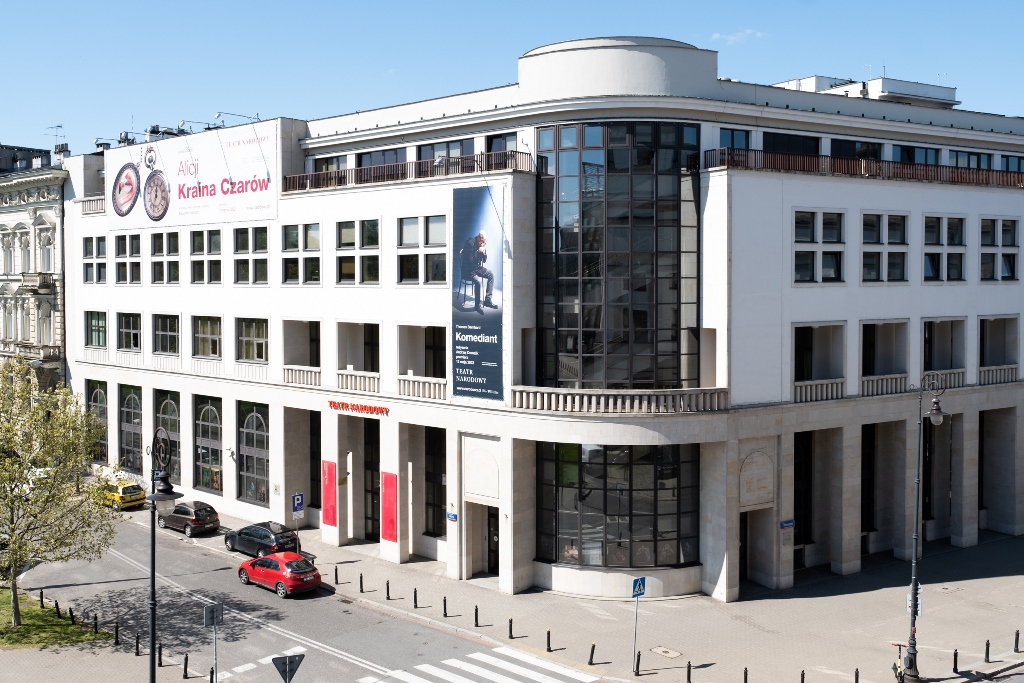
National Theatre, building at 3, Wierzbowa Street (The Jerzy Grzegorzewski Stage at Wierzbowa and Studio Stage). Photo by Marta Ankiersztejn
